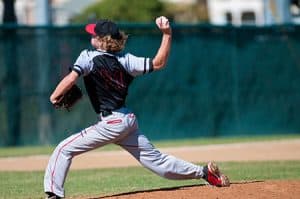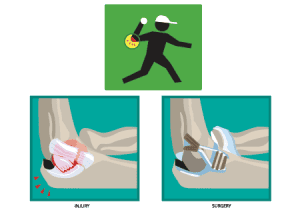Tommy John Surgery in Burr Ridge
Also Serving Plainfield, Morris, & Surrounding Areas
Experienced Chicago-area orthopedic surgeon Dr. David Burt outlines key facts about UCL tears, including anatomy, injury, symptoms, diagnosis, and treatment options.
What Is Tommy John Surgery?

Tommy John surgery reconstructs the ulnar collateral ligament (UCL) inside the elbow that secures the inner side of the elbow to the elbow joint. The procedure gets its name from Tommy John, a 1970s baseball pitcher who was the first to have ulnar collateral ligament reconstruction surgery and successfully return to playing his sport. UCL tears often happen in athletes playing throwing sports, and these injuries require surgery to repair the ligament so they can continue playing professionally or recreationally. Tommy John surgery replaces the torn UCL with a donor tendon to stabilize the elbow, reduce discomfort, and restore range of motion.
Anatomy
The ulnar collateral ligament attaches the medial side of the humerus to the ulna at the elbow and provides stability to the elbow joint. This ligament lives on the medial (pinky finger) side of the elbow and is stressed during athletic activities and with traumatic injuries.
Injury
- Injuries of this important ligament have a strong association with vigorous athletic activity, especially sports that involve repeated overhead motion, such as baseball, softball, and javelin throwing.
- A tear of the UCL may happen suddenly, such as when pitching a baseball, or from a traumatic elbow dislocation as may be seen in contact sports, or may happen slowly over time with repetitive stress from overhand sports.
Symptoms
- A UCL injury generates pain on the inner side of the elbow. A sufferer may feel a “pop” at the time of injury in acute cases. Other symptoms include swelling, bruising, or occasionally numbness and tingling into the ring and small fingers.
- Throwers will typically experience loss of speed and control of the ball and feel unable to get into their “slot” with pitching. Volleyball players will have pain, especially with serving, and javelin throwers will have pain and loss of distance and control.
Diagnosis
- Dr. Burt will typically evaluate the history of your problems and perform a physical exam, including a valgus test, which measures elbow instability. Evaluation also includes X-rays and an MRI to diagnose the severity of the injury.
Treatment
- With mild or partial injuries to the UCL, many athletes are able to recover by resting the elbow and following a course of physical therapy to strengthen the muscles that help support the ligament.
- Nonsteroidal anti-inflammatory medications and ice packs can also help treat symptoms in mild cases.
Surgical Option
For athletes who continue to have pain and dysfunction of the elbow preventing a return to sport, there are surgical options. Many tears that are partial and/or acute injuries can be treated surgically with ligament repair and augmentation with an internal brace. In more chronic cases it may require ligament reconstruction, commonly referred to as Tommy John surgery.
During this surgery, the ulnar ligament is replaced by a tendon taken from elsewhere in the body or from a donor.
- The new tendon in secured by threading it through holes drilled in the upper arm bone and lower arm bone. It is held in place by screws, buttons or sutures.
- Tommy John surgery is performed as an outpatient procedure under general anesthesia, and lasts about an hour to 90 minutes.
Recovery
- Recovery from Tommy John surgery involves intensive post-operative rehab, and takes about 12 months to return to full-speed throwing.
Tommy John Surgery FAQs
Where is the graft taken from for Tommy John surgery?
UCL reconstruction replaces the torn UCL with a tendon graft. These grafts can be harvested from another area in your body or from a human donor. The tendons typically used for Tommy John surgery include:
- The hamstring tendon in the thigh (gracilis tendon).
- Extensor tendon in the big toe.
- The palmaris longus tendon in the forearm.
How is the tendon graft attached during Tommy John surgery?
The harvested or donor tendon graft is typically connected to the elbow through drilled holes in the upper arm bone (humerus) and the lower arm bone (ulna). Dr. Burt threads the graft through the holes and secures the tissue in place using sutures, screws, or buttons. Our orthopaedic surgeon may attach the donor tendon using a figure-eight or docking approach.
How long will I need rehabilitation before returning to my sport?
- Immediately After Surgery: Your elbow is secured at an angle (60 to 90 degrees) right after Tommy John surgery to protect the surgical site and reduce swelling. Physical therapy may start right away with a focus on shoulder, biceps, wrist, and finger movements to prevent these muscles from atrophying (wasting away).
- One to Two Weeks After Surgery: Physical therapy for the elbow joint may begin around this time. You may have a hinged brace that locks in place when the arm is immobile or an arm sling. Physical therapy gradually increases elbow movements to improve range of motion, and these exercises are tailored to you.
- One Month After Surgery: Some patients can tolerate extending their elbow and may no longer need a brace. Ongoing physical therapy is necessary for several months to regain a normal range of elbow motion.

Athletes may need longer rehabilitation than other patients. Someone playing a professional throwing sport, such as baseball, may gradually return to practice about nine to 12 months after Tommy John surgery. Athletes may need to plan to miss one to two seasons of their sport and should continue aggressive strength training and stretching during and after practices and games to promote healthy elbow movement.
It’s common for athletes to complete up to one year of rehabilitation before returning to competitive throwing sports.
Schedule an Appointment Today
Dr. David Burt has years of experience treating orthopaedic injuries, including ulnar collateral ligament tears. He will evaluate your injury and recommend the appropriate treatment during your appointment. If you have suffered an elbow injury, schedule an appointment at Midwest Sports Medicine Institute. Contact our offices in Illinois today by calling our Burr Ridge location at (630) 455-2000, Plainfield at (815) 267-8825, or our Morris location at (815) 941-1885.
Dr. Burt provides orthopaedic treatment to patients throughout Chicago, including Joliet, Aurora, and Naperville.
Recent posts
Lateral Decubitus Position for Arthroscopic Suprapectoral Biceps Tenodesis

The purpose of this report is to describe arthroscopic suprapectoral biceps tenodesis in the lateral decubitus position. Many technique descriptions for this procedure emphasize the beach-chair position to obtain optimal anterior subdeltoid visualization of the relevant anatomy. This is not...
Read MorePhysician's corner: Dr. David Burt

Two years ago, Dr. David Burt opened up his third clinic with Midwest Sports Medicine Institute in Burr Ridge. Along with locations in Plainfield and Morris, Dr. Burt is able to treat countless of athletes of all ages and levels...
Read More
